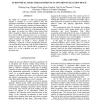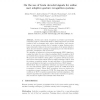26 search results - page 4 / 6 » Recognition of Human Activity through Hierarchical Stochasti... |
CVPR
2006
IEEE
14 years 9 months ago
2006
IEEE
We present a 3-level hierarchical model for localizing human bodies in still images from arbitrary viewpoints. We first fit a simple tree-structured model defined on a small landm...
CVPR
2003
IEEE
14 years 9 months ago
2003
IEEE
Understanding human emotions is one of the necessary skills for the computer to interact intelligently with human users. The most expressive way humans display emotions is through...
HRI
2006
ACM
14 years 1 months ago
2006
ACM
The essence of the signal-to-symbol problem consists of associating a symbolic description of an object (e.g., a chair) to a signal (e.g., an image) that captures the real object....
ICMCS
2005
IEEE
14 years 1 months ago
2005
IEEE
The ability of a computer to detect and appropriately respond to changes in a user’s affective state has significant implications to Human-Computer Interaction (HCI). To more ac...
PERVASIVE
2010
Springer
14 years 1 months ago
2010
Springer
Activity and context recognition in pervasive and wearable computing ought to continuously adapt to changes typical of open-ended scenarios, such as changing users, sensor characte...


